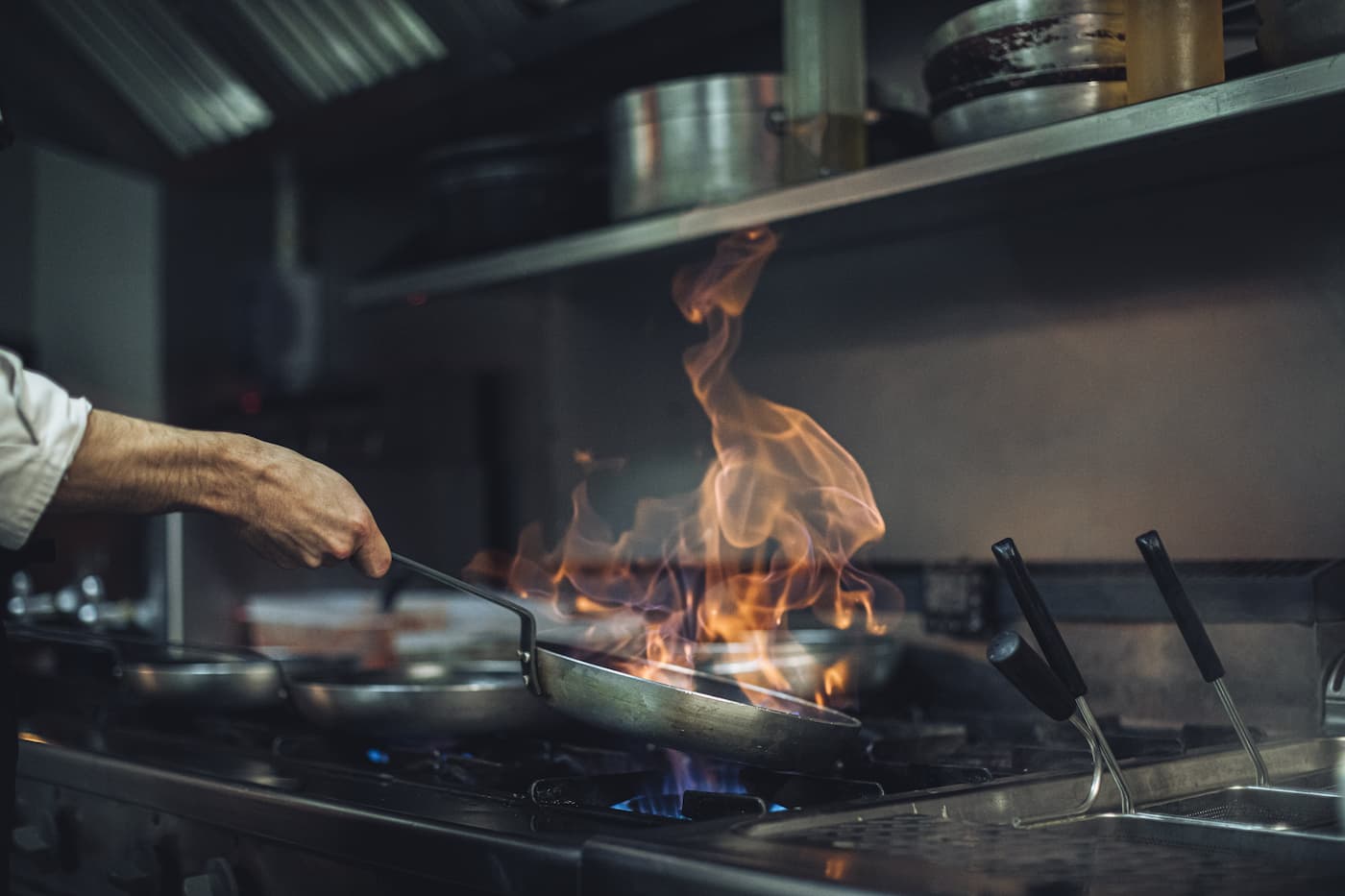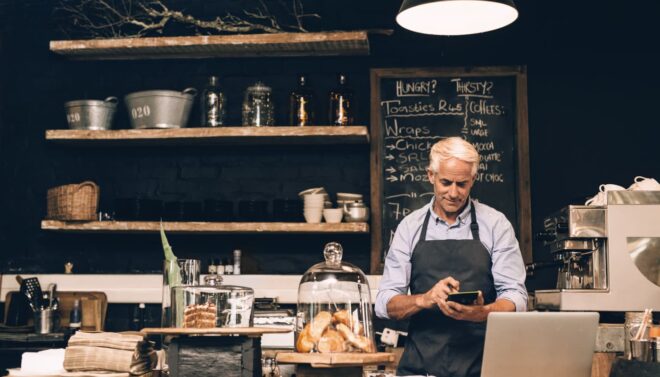List of essential equipment needed to start a restaurant
Editorial Team
11 min read
When entrepreneurs, chefs, and seasoned hospitality pros consider opening a restaurant, the conversation often revolves around factors such as location, staffing, and sourcing top-notch ingredients. However, having the right equipment on hand can make or break a business – especially if that equipment isn’t suitable for the menu or dependable over the long term.
While the equipment needed to start a restaurant may change depending on the different types of restaurants, there are some appliances and must-have machinery that almost all eateries will need on hand before they open their doors.
Standard restaurant equipment almost all restaurants need
1. Ovens
Want to roast a chicken, bake trays of croissants, or braise a few hotel pans packed with short ribs? Then you’re likely going to need at least a couple of ovens. There are several types to explore, including commercial ovens (designed with space and durability in mind); convection ovens (more popular with bakeries); combination ovens; and pizza ovens. Sandwich shops and coffee houses may benefit from a conveyor oven, which sends items through on a conveyor belt so that bread can toast and toppings heat up before service.
2. Ranges and ventilation
Ranges will likely comprise your primary cooking stations, while ventilation systems help expel hot air, steam, and smoke to maintain comfortable working and dining conditions for your staff and guests.
For ranges, you’ll need to consider how many burners you need and what type of heat and control you prefer (generally gas, though electric is also a possibility). For ventilation, you’ll need to build a system that’s powerful enough to cover the entire back line, yet quiet enough to avoid drowning out kitchen commands or infiltrating the dining room.
3. Refrigerators
What would a list of restaurant kitchen essentials be if it didn’t include refrigerators? Walk-in units, common upright appliances, and under-the-counter reach-ins are all commonplace in restaurants. You might want a larger walk-in unit in your back-of-house area to keep inventory deliveries. Then you can use reach-ins in your prep areas, on the dessert line, and behind the bar to hold smaller and more frequently used items such as coffee creamer, fruit, and garnish.
4. Freezers
Freezers maintain the proper temperature for items that must be at or below 0°F (-18° C). This includes everything from larger cuts of meat to ice cream and sorbet that’s kept frozen until the time of service. Larger restaurants may need the space offered by a walk-in freezer, while smaller eateries could make do with a reach-in unit.
5. Mixers
Pizza dough, cake and brownie batter, whipped cream – there are tons of uses for a commercial mixer. However, some restaurants (bakeries and brunch/breakfast places) might have more use for multiple mixers than, say, a high-end French eatery that focuses on a lot of handmade items. Stand mixers take up more space but require less attention. Hand mixers can be put in a drawer or hung on a post between uses and tend to be more affordable, but they only work when actively held and operated by one of your kitchen staff.
6. Slicers
Knife skills are a valuable asset in the restaurant world, but spending hours slicing onions or cabbage for coleslaw might not be the best use of your time when a machine could get the job done much faster. Slicers are essential for any restaurant that needs to process meats, cheeses, and/or vegetables at large volumes and high speed. You can buy high-powered units that run automatically or stock your restaurant with manual slicers that require some elbow grease but are typically more affordable.
7. Food processors
Professional kitchens rely on food processors to make quick work of tedious tasks such as grinding nuts, chopping herbs, slicing vegetables, shredding meat, and pureeing cooked fruit. Depending on your volume and menu, you could use a simple batch-bowl food processor, or you may want a continuous-feed food processor that runs automatically as you add in bulk goods.
8. Counters and cutting surfaces
You need somewhere for your team to do their prep work. Generally, medium and large restaurants will have separate countertops/cutting services for cold and hot lines (you don’t want to prep salad on the same board where someone else is slicing a roast). You’ll also need countertops for storage and expo. Stainless steel is a popular option because it’s tough, corrosion-resistant, and cleans up well.
9. Steam table
Steam tables aren’t for cooking but rather for keeping cooked items warm – including sauces and side dishes – so they’re ready to use when it’s time to finish a steak or pasta dish. A functional steam table will need the base unit, a way to fill and drain the base, a thermometer to ensure food is held at the correct temperature, and separate pans that sit in the base to hold prepped food.
10. Ice maker
Want ice for drinks, chilling food, and performing certain recipes? Then you’ll need an ice maker. Reach-in ice makers are an attractive option, but you’ll have to be very careful about contamination. Units that dispense ice into an ice bucket or other vessel can be more convenient. Either way, you’ll need to buy a unit that can produce enough ice for your entire operation, and remember to clean it regularly to prevent buildup.
11. Gas or electric grill
Burgers, kabobs, and yummy chicken sandwiches are just a few of the things that come off a restaurant grill. If you want to cook patty melts, bacon, and eggs on the “flat top,” you’ll need a griddle, too.
Actually, in most restaurants, the grill and griddle are one and the same. You won’t often see a grill with grates, as you’d use in your backyard at home, unless that’s brought in as a piece of specialty equipment. Flat-top or griddle-style “grills” are easier to control, offer more usable space, and are much easier to clean. Plus, you can add cheese to burgers or grill saucy items without losing everything through a grate.
12. Deep fryer
Use a deep fryer for fried items such as French fries, jalapeno poppers, onion rings, and eggrolls. It’s crucial not to overload your fryers, since it drops the temperature of the oil and results in greasy food. So, if you’ll be frying a lot of menu items, you may want to consider investing in more units.
13. Commercial toaster
Commercial toasters are must-have items for breakfast and brunch restaurants, as well as diners serving toast and sandwiches around the clock. You may opt for a larger version of your home toaster, with four or even eight slots, or you can get a conveyor toaster that toasts bread and bagels as the baked goods travel through the machine on a conveyor belt.
14. Coffee maker
Depending on your needs, you can get away with a simple drip coffee maker with slots for caffeinated and decaffeinated coffee. On the other hand, you may want to get fancy with an espresso machine that can churn out coffee and foam dairy products for cappuccinos, lattes, and other tasty beverages.
15. Cooking supplies and serving ware
This category covers all the utensils and accessories you need to cook and serve food to guests. That means pots, pans, roasting racks, spatulas, spoons, ladles, platters, plates, cups, bowls, bread baskets, butter dishes, etc.
Many cooks and chefs will bring their personal collection of knives to work, but it’s a good idea to have some communal-use knives available as well, along with commonly used gear such as a peeler, grater, colander, measuring cups, kitchen shears, and so on.
16. Sharpening stones
Dull knives are dangerous knives, and they also cut away at productivity. Keep sharpening stones on hand, so your staff can keep their equipment in tip-top shape.
17. Storage containers, racks, and shelving
Everything in the kitchen should have somewhere safe to live when not in use. For dry goods such as rice, flour, and pasta, there should be resealable containers that are properly labeled and kept away from moisture and direct light. Canned goods should be kept on racks. Cookware and utensils can also be racked or hung, whichever makes more sense given your space and daily operations.
18. Sinks
Restaurants cannot legally operate without working sinks. Though specific codes and regulations can differ from area to area, generally speaking, the local health inspector will check that you have operating sinks and hot water before you’re allowed to open for business. You may also be required to have triple-wash sink stations behind the bar (wash, rinse, sanitize), separate sinks for handwashing, and a dishwashing unit that sanitizes in bulk.
19. Washing equipment
Expanding on the dishwashing mentioned above, most restaurants can’t run without a dishwasher. It’s simply too difficult to keep up with the lunch and dinner rushes without having a fast, dependable way to tackle all the dirty dishware, cups, and cutlery used by guests.
You may want to have a second dishwasher behind the bar. These units are smaller and hold a handful of glasses, so bartenders can clean delicate cups and champagne flutes as needed.
20. Safety equipment
Safety equipment is an umbrella term covering all the items you need to have on hand to properly sanitize your restaurant, react to a fire, and protect your staff in case of an accident.
- Fire safety is very important – remember all those ovens and ranges? Study your local fire code and see what you need in terms of a sprinkler system, fire extinguishers, and alarms.
- For general safety, you’ll need a first aid kit and items such as rubber floor mats, aprons, oven mitts, wet floor signs, and goggles that can help prevent accidents from happening in the first place. Security cameras – especially on the exterior of your property and in the parking lot – and proper lighting can help protect staff members and guests who may be leaving late at night.
- For sanitization, you’ll need appropriately labeled spray bottles and buckets with a sanitizing solution; a schedule that outlines cleaning protocols; and other pieces of equipment such as mops, sponges, and rags to facilitate cleaning multiple types of surfaces.
21. Kitchen display system
A kitchen display system (KDS) is basically a digital screen that displays orders so your back-of-house team can track what’s coming from the front-of-house team. These displays are usually programmed to fit the restaurant’s needs, with color-coded text to show where in the workflow an order falls and/or which station is in charge of which item. These displays make it easier for cooks and prep workers to see what’s in progress, what’s coming, and what’s already on the way to waiting guests.
22. POS system
A restaurant POS system is the heart of businesses based around food. These incredible systems are best known for handling on-premises and delivery/takeout orders, but they can also be used for administrative tasks such as scheduling, labor costing, customer relationship management, inventory reports, authorizing and processing payments, and tracking loyalty points for rewards programs. Look for a POS system that can integrate with apps and services you already use and love – including third-party delivery companies – to streamline operations even more.
What to consider when buying essential restaurant equipment
As you build your list of standard restaurant equipment, there are a few things to consider.
Equipment will account for a chunk of your restaurant startup costs. Used equipment typically costs less, but it may be less reliable. Try to balance budget with quality. It’s not worth saving a few hundred dollars on a mixer or reach-in fridge that will need lots of repairs or impact your ability to properly serve guests.
Also, consider how equipment will be installed and maintained. New equipment may be under warranty and include a service agreement that covers installation and a certain period of free or reduced-fee maintenance. You may get a similar deal for certified used equipment, too, but it depends on the seller and type of equipment.
Wherever you buy, always read the fine print to determine return policies and any “lemon clauses,” and test for functionality before you hand over your credit card. The efficacy and efficiency of your restaurant equipment is a major factor in long-term success, but it’s not the only element you need to consider.
Clover offers a wide range of business solutions that help restaurants run more smoothly. Contact a Clover Business Consultant today to see how we can help.
CONTACT SALESRelated Posts
10+ Spring holiday promotional ideas to help your restaurant business flourish
Average restaurant profit margin and revenue: What they mean for your business
Popular Topics
Stay in touch
Sign up and learn more about Clover.
Thank you for your subscription!
More posts about starting a small business
eBook
Retail roadmap: Financial goal-setting for the year ahead
Please share your contact information
to access our premium content.
Thank you for sharing your contact information.
Download Now





